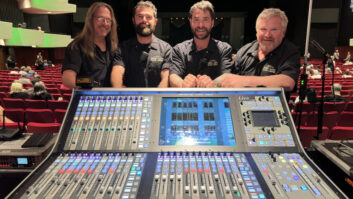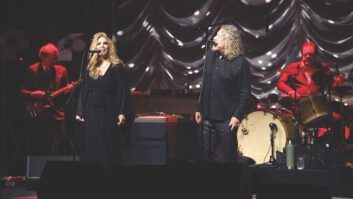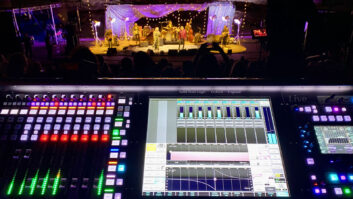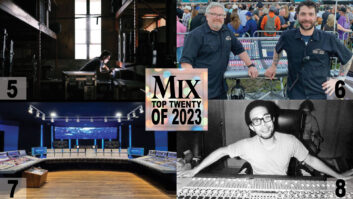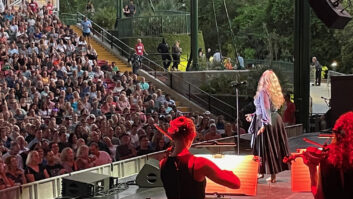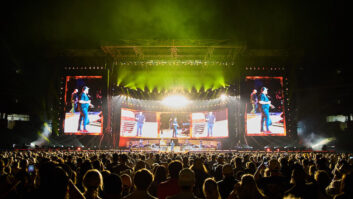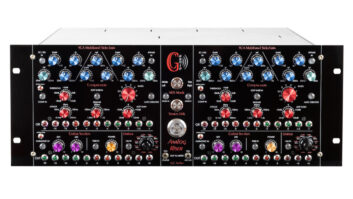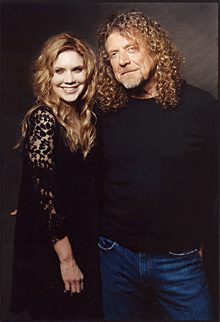
That whipping sound you all heard a few months ago was a million heads doing a fast double-take at the announcement that former Led Zeppelin belter Robert Plant and bluegrass queen Alison Krauss were teaming up to make a CD together. Say what? Actually, if you think about it, it does make sense. Plant has had folk and country influences in his music dating back to early Zep, and has flirted here and there with rockabilly shadings in his solo work; and Krauss — well, she can play anything and is a natural collaborator, so it’s no surprise she found common ground with the versatile Englishman. Even so, I don’t suspect many would have predicted they would make an album quite like Raising Sand, which is surely one of the year’s most pleasant musical surprises.
Produced by T Bone Burnett (and recorded and mixed by his usual engineer, Mike Piersante), this eclectic and refreshingly low-key album serves up a wonderful collection of mostly obscure cover tunes by a great cross-section of songwriters, including Gene Clark, Tom Waits, Townes Van Zandt, Sam Phillips (the singer/songwriter, not the Memphis producer), Roly Salley, the Everly Brothers and others. The singers are ably backed by Burnett’s most recent core band — himself and Marc Ribot on guitars, acoustic bassist Dennis Crouch and drummer Jay Bellerose — augmented on a few tracks by stellar players Greg Leisz on steel guitar, Patrick Warren on keys, Norman Blake on acoustic guitar, Riley Baugus on banjo, Mike Seeger on autoharp and, on two tunes, Krauss on fiddle. There’s nothing flashy going on here, vocally or instrumentally — just a fresh, spontaneous and imaginative ensemble playing behind a pair of pros whose voices seem to meld effortlessly.
As with so many of Burnett’s productions, there’s a haunting retro feel to both the arrangements and the sonics; modern songs aside, this album sounds like it could have been made in 1959, and that’s a good thing. Guitars float in seas of tremolo and reverb, drums whisper the beat, the standup bass thwacks with swinging authority and the vocals gracefully intermingle within the spare soundscape. From the rubbery rockabilly drive of the Everlys’ “Gone Gone Gone,” to the scrumptious harmonies of “Killing the Blues,” to timeless folk of “Your Long Journey,” this CD covers a lot of stylistic ground, but always retains its own characteristic sound.
Plant and Krauss first teamed up on four songs at a 2004 tribute to Leadbelly at Cleveland’s Rock and Roll Hall of Fame. Hitting it off both personally and professionally, they found they had many of the same influences and interests. Plant was the one who first suggested they get together to make a CD, but it was Krauss who suggested producer Burnett, who turned out to be the linchpin in the project. It was Burnett who suggested most of the songs that were ultimately recorded for Raising Sand, and, of course, he put together and directed the band.
“T Bone always goes to great lengths to put together song lists and recommendations,” notes engineer Piersante. “It’s no secret that T Bone’s well runs very deep. [Laughs] He knows so many obscure songs, so he’ll put together these lists and then he’ll pare them down and also still find new things all the time. Then he ends up with CDs of original versions of the suggested songs. In this case, Robert knew most of the songs — he also has a vast knowledge of musical history — and Alison was also very much involved in selecting the songs. It was a very collaborative effort.”

Indeed, the three of them also spent an afternoon at Krauss’ Nashville-area home figuring out who would sing what and in which key, and discussing the basics of how the arrangements might come together. Then, Piersante says, they flew in some of Burnett’s regular players — what Piersante calls “our Kill Squad band” — to Nashville and set up shop at Sound Emporium, “our usual Nashville haunt,” he says. “It kind of feels like home when we go there. We’ve made some good albums there [including the Grammy-winning soundtrack to O Brother, Where Art Thou?]. They have a nice 81 Series Neve there, which we basically used as a playback desk during the tracking, so we obviously rented gear to record through and go straight to tape with it.”
I ask incredulously, “When you say tape, do you mean tape?” “I do mean tape,” he replies with a laugh. “We ran a Studer [multitrack] with 2-inch tape. That’s really our preferred way of working. We did another recent tracking date with John Mellencamp and used tape for that, and we’re doing a B.B. King record now and we’re running that to tape. And we still mix through an analog console. For us, nothing sounds better to our ears, so we still stick with what we know and like.
“This project sort of started as an experiment,” he continues. “It was, ‘Let’s get together and cut a few songs and see how it goes and then we’ll figure it out from there.’ But we shipped in massive amounts of gear — T Bone’s guitars and amps and microphones and things — so I think we were always thinking, ‘We’re gonna really try and dig into this thing and make it work.’ From the beginning, I was thinking very vintage and authentic-sounding. So we recorded the band live, and I had Robert and Alison in a booth kind of facing each other at about a 45-degree angle.”
As for the all-important vocal mics, Piersante says, “I actually bought a mic, as I’ll sometimes do, just for this project. I had Allison singing through a Blue Cactus, which is sort of their retro mic that’s like an old [Neumann] M49 or something. Blue got it right with this — it has a real thick quality to it and it’s not too bright. Alison can be a fairly bright singer and I wanted something to complement that and not accentuate it. So I chose this mic to try on her and it ended up sounding very good; very old tube-sounding. I probably had her through an LA2, as well. Robert sang on one of T Bone’s [Neumann] U47s, and I probably had an LA2 or LA3 limiter on him.

Engineer Mike Piersante with Robert Plant
Photo: Callie Khouri
“So I had the idea of that classic chain I described, and then I thought, ‘I’m going to make a super-retro chain for both of them,’ and hang these RCA 44s right under their mics and they’ll be kind of singing into both of them at the same time and I’ll have my options. Well, the magnets in those things created the biggest hum you can imagine, so I ended up getting rid of all that and going with the classic tube mic sound and limiter. For preamps, I had Neve 1073s and some 1081s.”
Piersante used a fairly straight setup on the band from song to song, “but [drummer] Jay Bellerose did a lot of reconfiguring between songs. He was definitely setting up things for each particular song, which was really great. It kept me real busy setting up mics and moving them around and getting new sounds. He’s such a great player. He tends to play really quietly like T Bone likes him to do, so just the mic on the tom, for example, will be picking up a lot of room because he’s playing soft, and we just crank that up and pump it. So you get room mic in there by default. I didn’t really have to do any tricks on this music. It was really a matter of capturing what these guys are doing and presenting it in the best light.”

The crowd at Sound Emporium (L-R): drummer Jay Bellerose, banjo player Riley Baugus, Alison Krauss, guitarist Norman Blake, Robert Plant, guitarist Marc Ribot; producer T Bone Burnett, engineer Mike Piersante and bassist Dennis Crouch
Photo: Callie Khouri
Typical of Burnett’s style, he was looking for a certain spontaneity in the performances, so none of the songs were rehearsed much before the two weeks of tracking in Nashville. “Everything was learned on the spot,” Piersante notes. “It was all very gut-reaction. T Bone, Robert and Alison would agree on a certain approach to the arrangement, they’d get together with the band, work through it a bit and then cut it immediately — hopefully before the song is learned too well so it’s still fresh and not too perfected. A few songs on are actually first takes, vocals and all.”
Rather than comping together performances from multiple takes, each song represents a complete performance by the band, though there are judicious instrumental overdubs and selected vocal re-takes. “Marc [Ribot] would come in at night and do overdubs,” Piersante says. “He’d get his part for the track and then he’d come in later and have 10 new ideas: ‘Oh, man, I hear this!’ He has ideas pouring out of him. Some of them we’d use, and some of them we wouldn’t.”

From left: Bellerose, Baugus and Blake play as Krauss and Plant look on.
Photo: Callie Khouri
Mixing and further vocal and fiddle overdubs were done in L.A. at Burnett’s Electro Magnetic Studios, which is centered around a vintage Bushnell board that once resided at Sunset Sound and Piersante’s beloved Westlake monitors. Again, the approach was to keep the sound simple and real, though there was a certain amount of experimentation at the mix stage. “‘Gone, Gone, Gone’ was [a mix] we looked at a whole lot of different times and tried different things; we went back and mixed it several times, and then went back to the first mix we did, which was actually the first mix we did on the album,” Piersante says. “We really explored a lot of avenues with that.”
In the end, though, the album was more romp than rigor, and the finished product shows that. “We had a lot of fun,” Piersante offers. “In fact, it’s probably one of the most fun sessions I ever did, outside of the fact that when I flew into Nashville and was setting up the night before the session and I developed an abscessed tooth, and I realized I was stuck there for two weeks with a tooth that had gone bad. But the sessions were really fun because of the personalities involved: Alison loves to laugh and joke around, and so does T Bone, and I gather Robert is an instigator from way back. So with the three of them together, it was really a blast.”
As just one example, he cites “a day when we were all here doing overdubs at T Bone’s, and we put Alison in the foyer with the high ceiling to do a fiddle part, but she was not having fun with it for some reason. Maybe she wasn’t feeling it on the track, or something. So she starts playing a little hoedown version of [Led Zep’s] ‘Whole Lotta Love,’ and that spun Robert off the couch and he runs out there and starts dancing in his boots and singing along with her. Then T Bone comes walking down the stairs with a toy piano and they all had a little Zeppelin hoedown going on. I was rolling on the floor crying, hoping I’m recording it. I don’t know if anyone will ever hear it, but it was priceless. We all had such a great time and that’s really what the whole record was about — having fun.”
